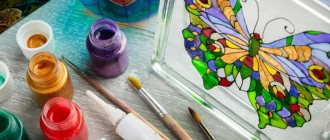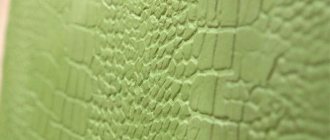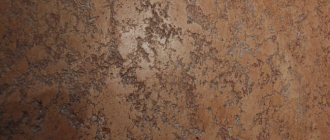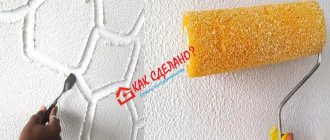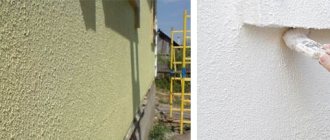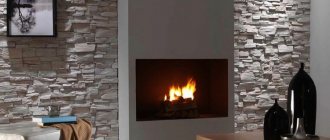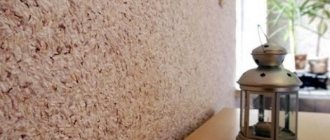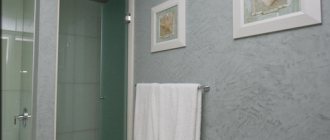- October 30, 2018
- Decor
- Alisa Krasnova
Stained glass windows have been decorating cathedrals, mansions and mausoleums for a long time. Medieval parishioners saw heavenly light in such glass. Nobles and wealthy merchants also decorated their homes with them to show their wealth and status. In this article we will tell you how to draw stained glass on glass and transform your home.
Preamble
In the Middle Ages, plain glass, not to mention colored glass, was an expensive product. Even an ordinary person could not afford it, preferring to decorate their houses with wooden shutters. The stained glass window itself was religious in nature. Geometric patterns, which were seen as a representation of the perfection of God, were especially popular. And such glass greatly transformed the holy place, creating a unique atmosphere.
Today, stained glass windows are simply a beautiful decoration that can be found in any secular home. The right tools and materials, patience and desire will help you create unique colored glass yourself.
Peculiarities
Before you learn how to draw stained glass on glass with your own hands, let's look at what features it has. Considering these nuances, you can create a unique decoration at home:
- Stained glass can look different, it all depends on your imagination. Try depicting a bouquet of your favorite flowers, a large castle, a fancy mosaic, or even an inscription.
- Stained glass windows are one of the most striking decorative elements. They bring classic charm to the house, add lightness, airiness and unique style, and also create a particularly warm atmosphere. Stained glass windows in the interior transform the space, making it festive, sophisticated and luxurious.
- Previously they were made by hand. Complex structures were literally assembled piece by piece and soldered together. Today, stained glass can be made using simple means.
How to mix stained glass paints and get new shades?
Unfortunately, not all manufacturers of stained glass paints have such a large selection of paints as the French Pebeo Vitrail, for example. Don't despair, because paints can be mixed to get the desired shade!
To obtain new colors and shades, use a special container with indentations. Although you can get by with regular plastic bottle caps and other available containers.
Old cream jars make excellent containers for mixing paints.
Start mixing with a small amount of paint... it is important to remember that dark colors are easier to create than light colors. In any case, knowledge and skills come with practice. Try mixing and creating your own interesting colors and shades!
We use available material: paper
You don't have to use paint to paint a stained glass window. You can decorate a window, mirror or interior glass door using colored paper. Helpful Tips:
- Tissue paper is best because it is translucent, inexpensive and easily available. But to create a realistic glass look, it's worth working with colored cellophane.
- Think in advance about how your stained glass window will look, taking into account the combination of tones and the size of the parts.
- Paper or cellophane is best applied to glue. If you are using the film specifically for window glass, then it is attached using ordinary water and careful smoothing.
- The main feature of any stained glass window is the highlighting of details with a black outline.
Simple step-by-step instructions
Cut the colored material into small pieces. The outline can be made using thicker paper or thin rolled napkins. To make stained glass look natural, try cutting out a template from thick cardboard.
- Step 1. Take the template, turn it over and coat it generously with glue. You can use regular PVA and a thin brush.
- Step 2. Glue cut pieces of colored paper onto the template. Choose the order of the shades according to your personal preference.
- Step 3. Let the stained glass dry, and then stick it to the glass using glue or double-sided tape.
- Step 4. Have you decided to remove the finished template? Use a rubber scraper and acetone to remove any remaining adhesive from the glass surface.
How to correct defects and remove stained glass paints from glass?
A novice artist almost always encounters problems when working with stained glass paints: he accidentally “blurs out” more material, paints over the outline, creates bubbles... These defects need to be corrected immediately, before the paint dries.
Bubbles, for example, can be conveniently “expelled” to the contour, or “burst” with a needle or toothpick. And excess paint can be removed with a brush or cotton swab.
Paint that has leaked beyond the contour can be removed with a clean brush dipped in solvent.
It is convenient to clean an accidentally painted outline with a brush or stick dipped in solvent or water (depending on the base of the stained glass paint). Using a solvent can completely remove stained glass paints from glass before they dry.
Glass painting
Painting stained glass windows with your own hands is quite simple if you stock up on the necessary materials and patience. The most difficult thing is to choose the perfect pattern and colors that will look harmonious. The best solution would be to make templates and sketches in advance to imagine what your window, room partition, mirror, vase or favorite mug will ultimately look like.
Important note! Ordinary paints (gouache, watercolor) will not be suitable for painting stained glass. They are easy to wash and make cleaning difficult. To make stained glass painting look natural, you need contours on the glass and special paints. Let's look at their types:
- Contour paints. They can be found in any art store, the main companies are Pebeo, Decola, Hobby Line. These paints are thick and have a special cap to make contouring easier. They will imitate soldering of glass, and it will seem that your stained glass window is real and not painted.
- It is best to fill the space between the borders with special paint, for example, solvent-based. However, this material has a sharp, characteristic odor, so it is best to work with a respirator and in a well-ventilated area. If you just want to practice, you can use simple artist's paints (inexpensive and easily available). Main companies: Pebeo, Marabu.
How to paint with stained glass paints?
Pouring paint and filling in the elements in stained glass painting is perhaps the most interesting part. You need to start filling each sector from the core, gradually painting the areas next to the outline. At the same time, it is not advisable to “climb” onto the contour itself, otherwise the painting will look sloppy and not so impressive.
You can start learning to paint with large flower buds
The background can be painted last. But there are other options for painted glass paintings, where the main background consists of acrylic paint and... newspaper! This decorative design of a glass picture looks harmonious in an ensemble with stained glass varnish paints!
Especially for lovers of stained glass painting, I develop and record Master classes in video format. One of these lessons may be suitable even for beginners, since it is “chewed” in detail and will be understandable to everyone. It is also ideal for those who want to enjoy a quiet lesson as Art Therapy for relaxation and calm.
The process of creating a mural
To paint stained glass on glass, you need to degrease it. In the worst case, the paints will not adhere to the surface, and bubbles may form that will ruin the appearance. Degrease the glass using soapy water, a soft towel and an alcohol solution. Please note that there should be no lint left on the surface from fabric or napkins.
How to paint stained glass with paints is described in detail below:
- Prepare the glass surface.
- Use a special washable marker, such as a chalk-based one. This will help draw the boundaries of the contours and create an overall picture.
- It is best if you create a ready-made mock-up of the future stained glass window on a computer or paper, having thought through in advance all the colors that will fit perfectly with the design of your home. How to draw a stained glass window with a pencil, see below.
- If you are a beginner, do not take too complex patterns and objects. Try painting stained glass on glass rather than on a vase or mug.
- After you have outlined the boundaries with a marker, start applying the outlines with paint (black, brown), and then leave until completely dry.
- Pouring stained glass paint is another stage of work. To make it easier to apply the material to the surface, it is best to use round brushes - hard and artificial. Natural pile often falls off, which can ruin the aesthetic appearance of the decoration. Stained glass paint often spreads, so you need to keep an eye on this by applying it to the surface in small portions and carefully leveling it, collecting any residue that has accumulated in the corners.
- The last stage is varnishing the coating. This must be done only if the vase, glass or mug will be washed frequently. Use Maimeri Idea Decoupage glassy varnish and a flat brush of different widths.
Little tricks
Stained glass is a decorative picture that can be made in any style.
Masters often keep silent about some, in their opinion, insignificant details. Here are some tips to help you make stained glass:
- Never start learning with the most complex, start with the simplest. Never take on a large drawing with many small details at once. Try a simple pattern first, and when you master the technique a little, you can take on complex designs.
- use different types of paints for your work, they all also apply to the drawing differently. The brightness and light transmission of the design depends on the number of layers of paint.
- To carefully adjust the pattern, use ear sticks and cotton pads.
- Use a sharp knife or blade to remove defective lines.
- Use wet alcohol wipes on your hands.
- The lighting should be good both from below and from above the work in order to immediately reveal the shade of color and the density of the coating.
- One of the main components of beautiful and neat work is its quick completion. For example, if you apply the contour paint too slowly, it will vary in both color and thickness. If poured slowly, the paint will lay down in an uneven layer and this will affect the quality of its surface.
Related article: Plasticine applications on cardboard: technology and templates for 1st grade
Is it possible to draw a stained glass window with a pencil?
To work, you just need to stock up on bright colored pencils, paper and an eraser. On the surface you need to draw a sketch using “broken” shapes, as if the picture was really made of soldered pieces of glass. Color the details with colored pencils. You can highlight the borders using a black marker, felt-tip pen or paint (watercolor, gouache). Also try making a frame using thick cardboard, paper and PVA glue.



